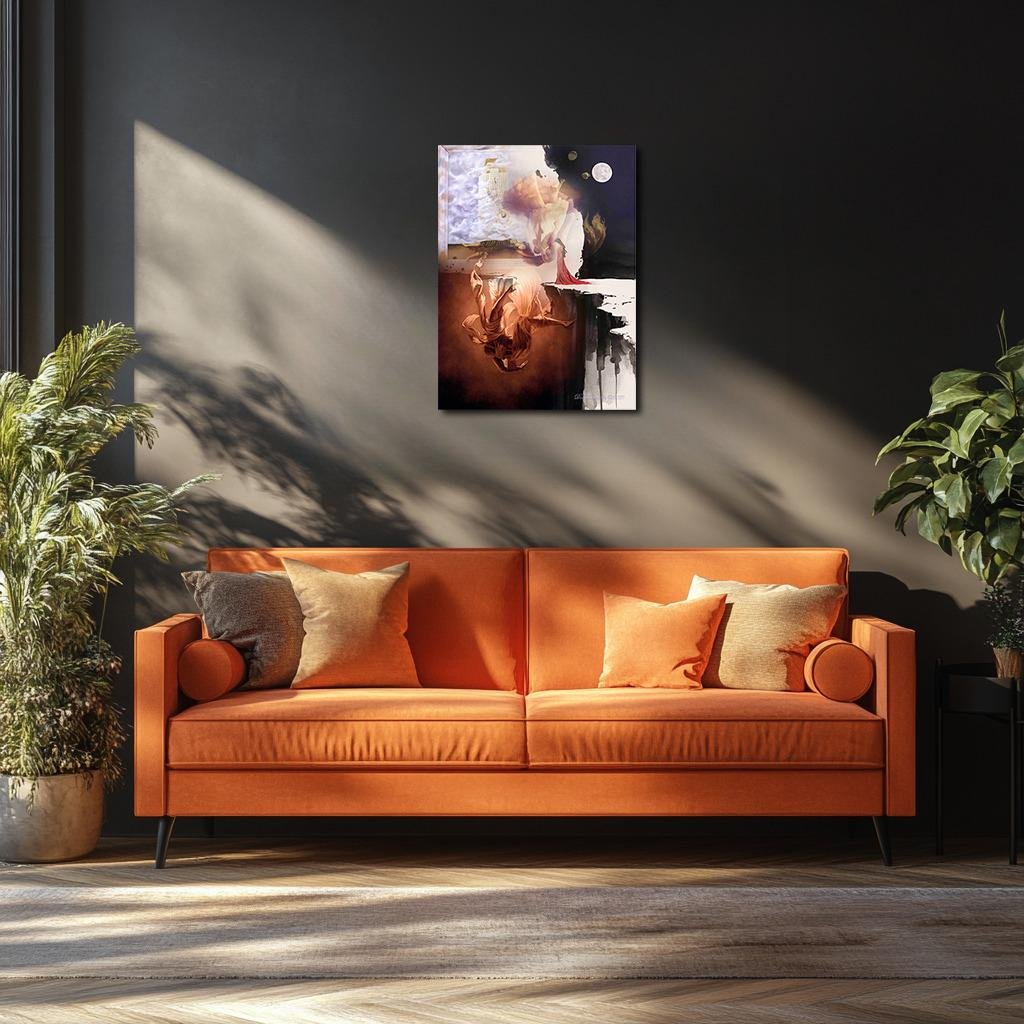The Descent of Silence: Frida’s Witness to a Final Fall
The Descent of Silence reimagines Frida Kahlo’s The Suicide of Dorothy Hale as a multi-layered elegy of grief, where a woman’s fall becomes a slow unraveling of self, soul, and memory. Through ghostly ivories, blood reds, urban grays, and lunar whites, Dorothy's descent is portrayed not as singular, but as a repetition of ache. Beneath a cold city and a glowing moon, fragments of her body spiral in dreamlike choreography, witnessed by a lone figure kneeling at the cliff of memory. This piece is not about death—it is about the silence that follows, and those who dare to look into it.
Please see Below for Details…
Hotline Order:
Mon - Fri: 07AM - 06PM
404-872-4663
This conceptual reimagining of Frida Kahlo’s The Suicide of Dorothy Hale transforms the deeply personal tragedy of a woman’s death into a layered meditation on grief, surrender, and the fragmented echo of finality. Titled The Descent of Silence , the piece reframes Dorothy Hale’s fatal leap not merely as an act of despair, but as a descent into the layered folds of memory, myth, and a fractured self—a fall painted not in spectacle but in ache.
At the center of the composition, Dorothy’s form is rendered in multiplicity—falling, floating, reaching, and finally still. Her figures spiral through veils of translucent fabric that wrap and unwind around her descent like ghostly choreography. Her red dress blurs into streaks of wind and ash, turning motion into haunting softness. She does not crash—she unravels.
To the left, a window opens into the painted cityscape of a cold New York sky, reminiscent of Kahlo’s original setting. The building rises like a tomb, its lines harsh and indifferent, indifferent to the body slipping past its frame. Dorothy’s face appears ghostlike in the cloud, already half-dissolved in dream logic. Her body floats midair, her arms extended upward as though in final prayer or protest, even as her soul slips downward, folding in on itself like petals after frost.
On the right, a solitary figure in red kneels at the edge of a pale cliff, gazing into a black abyss beneath the full moon. This figure—part witness, part embodiment of Frida herself—holds no expression, no resistance. She is there to bear the fall, not to stop it. Beneath the cliff, shadowy figures swirl in ghost-ballets, representing Dorothy’s psyche: grief, isolation, and the muted scream of a life fading in silence.
Above, the moon hangs in stark contrast to the darkness, glowing in shades of pearl-white and ghost-gray. Around it orbit three smaller spheres—echoes of thought, time, or fractured moments that replay again and again. The night sky wraps around the scene, not in menace, but in quiet comprehension. This is the color of aftermath.
The color palette of The Descent of Silence is one of emotional weight and spectral disintegration. The cliff and sky are painted in soft, creamy whites and inky blacks—stark opposites that bleed into each other like watercolor despair. The descent itself is rendered in blush tones, delicate ivories, muted browns, and cool grays, allowing Dorothy’s form to remain visible, yet slipping from solidity. Her red dress—the most persistent color—is carried throughout in varying intensities: blood red, rose, maroon, and dusty crimson, all signaling love, violence, memory, and loss.
The window scene in the upper left echoes Kahlo’s original tones of cold modernity—hospital whites, urban grays, and sterile blue shadows. The city feels distant, unmoved. In contrast, the figures dancing through the abyss at the bottom are painted in sepia and smoky bronze, flickering like candlelight in a locked room—fleeting, mournful, and unreachable.
The kneeling figure on the cliff is cast in delicate wine-red, framed by the moon’s gentle light. Her outline is defined by soft shadow and pale flame, as if she is becoming the line between witness and ghost. Her stillness anchors the chaos below her, suggesting both helplessness and devotion.
When I created The Descent of Silence , I wanted to hold space for the unbearable weight behind Kahlo’s original commission—how Frida, asked to memorialize a suicide, responded not with distance, but with brutal, raw witness. In Kahlo’s original painting, Dorothy Hale’s fall is literal, sequential, almost forensic. In this reimagining, I chose to fragment that sequence into symbolic layers—each fall a memory, each fold a scream held too long.
This is not a narrative of spectacle or sorrow—it is a meditation on the way grief fractures space, and how a soul might fall not once, but again and again in the mind of those left behind. The viewer is not asked to judge, only to feel.
The composition rises and falls with emotional rhythm. The eye is drawn from the red-cloaked mourner, to the drifting body above the skyline, to the downward spiraling limbs, and finally into the dark beneath the cliff—where memory pools like ink. The circular motion creates a sense of repetition, of reliving the moment that will not end.
In this vision, Frida Kahlo is not simply the painter—she is the silent witness on the ledge, the soul folding in descent, the red dress left behind in the wind. Through her, this work asks not for answers, but for empathy. For the willingness to kneel beside sorrow and remain.
Add your review
Your email address will not be published. Required fields are marked *
Please login to write review!
Looks like there are no reviews yet.








